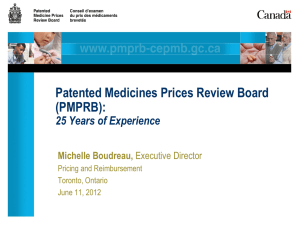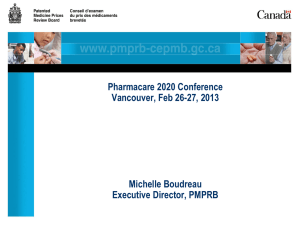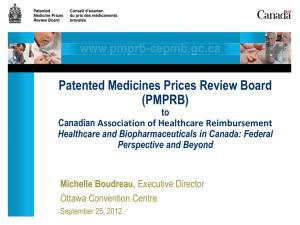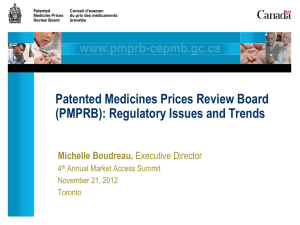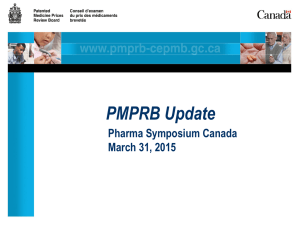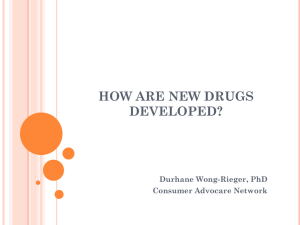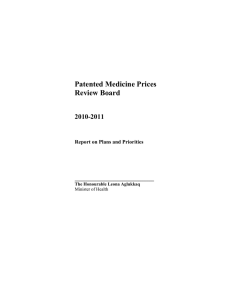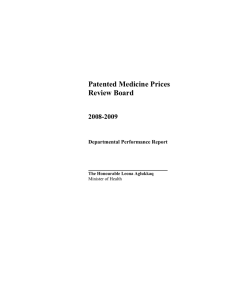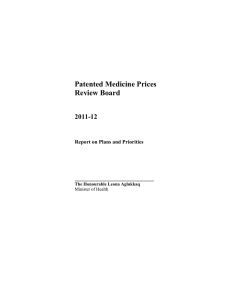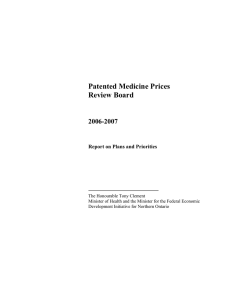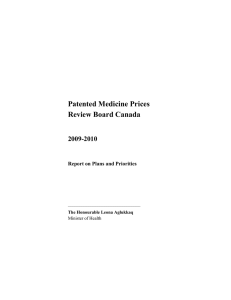PPTX - Patented Medicine Prices Review Board
advertisement
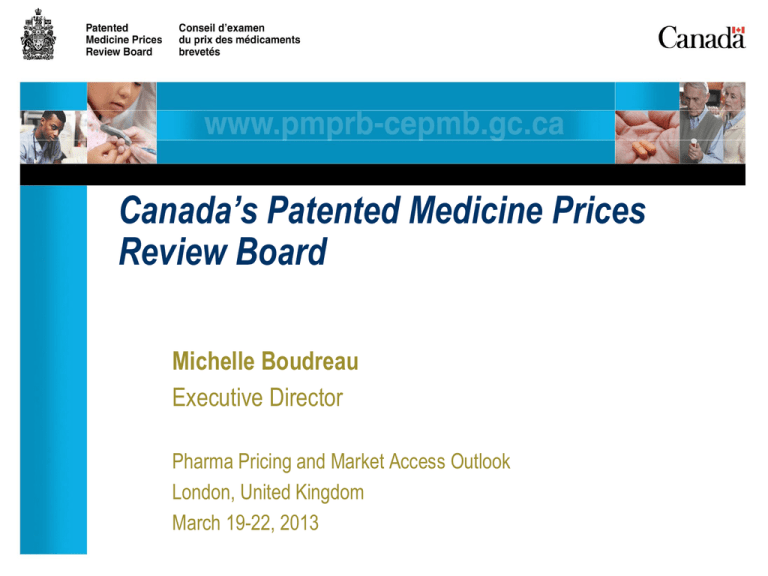
Canada’s Patented Medicine Prices Review Board Michelle Boudreau Executive Director Pharma Pricing and Market Access Outlook London, United Kingdom March 19-22, 2013 Outline ________________________________________________ Overview of the PMPRB How the PMPRB really works. Canada Compared to the World Common Challenges Looking Forward 2 Overview of the PMPRB ________________________________________________ Established in 1987 as consumer protection pillar via amendments to Patent Act The PMPRB is an independent quasi-judicial body with a dual mandate: Regulatory: To ensure that prices charged by patentees for patented medicines sold in Canada are not excessive Reporting: To report on pharmaceutical trends of all medicines and on R&D spending by pharmaceutical patentees Jurisdiction 3 Regulate prices patentees charge (i.e. factory-gate price) for patented drug products sold in Canada, to wholesalers, hospitals or pharmacies, for human and veterinary use How does it really work - price tests ________________________________________________ Blend of therapeutic improvement & international referencing Recognize incremental pharmaceutical innovation At introduction, price premium aligned with therapeutic improvement: Four levels of therapeutic improvement: 1) 2) 3) 4) Breakthrough – Median of International Price Comparison (MIPC) Substantial Improvement – Higher of top of Therapeutic Class Comparison (TCC) and the MIPC Moderate Improvement – Higher of mid-point between top of TCC test and the MIP, and top of TCC (primary & secondary factors apply here) Slight/No Improvement – Top of TCC After introduction, PMPRB monitors average prices, CPI increase permitted but at no time can price be higher than highest international price (HIP) 4 How does it really work – PMPRB ceiling price compared with public price ________________________________________________ Drug Pivotal Test PMPRB ceiling price Patentee Publicly introductory available price price (average) Brand-X TCC 2.45 0.68 0.69 Brand-Y TCC 1.52 1.50 1.50 Generic-A TCC* 0.65 0.42 0.33 * Brand price sets the MAPP – brand price $0.65 5 Regulatory Statistics Approximately 1,200 patented drug products under PMPRB jurisdiction 2011: 109 New Drug Products introduced : 79% within Guidelines; 9% outside of Guidelines but do not trigger an investigation 12% under investigation 69% were of slight or no improvement; 25% of moderate improvement; 5% of substantial improvement and 1% breakthrough Between 2000 and 2010, average of 84 new patented drug products/year High level of compliance: average rate is approximately 95% Since 1993: 6 90 VCUs 26 public hearings $137 million collected through VCUs and Board Orders PMPRB Price Tests - International Referencing ________________________________________________ Reference pricing at introduction and for existing drugs based on 7 comparator countries - France, Germany, Italy, Sweden, Switzerland, UK, and US Policy changes in these countries could impact prices in Canada Over last 3 years, Germany has most often been the highest referenced price for PMPRB price tests (“HIPC”), followed by US 7 Recent cost containment measures by reference countries, like Germany, may therefore lead to lower prices in Canada Canada Compared to the World ________________________________________________ Canadian prices comparatively higher than a number of OECD countries 2.50 Avg Bilateral Foreign-to-Canadian Price Ratios: Top 300 selling oral solids in Canada 2.00 1.50 1.00 0.50 0.00 IMS Health Data, 2010 8 Canada Compared to the World (cont’d) ________________________________________________ Growth in drug sales outpacing comparator countries 9 Canada Compared to 21 EU Members - 2010 AVERAGE BILATERAL FOREIGN-TO-CANADIAN PRICE RATIOS 1.06 Germany Canada Denmark Ireland Sweden Luxembourg Belgium Austria Spain France Netherlands United Kingdom Greece Finland Hungary Poland Portugal Italy Slovenia Slovakia Estonia Czech Republic 0.93 1.00 0.98 0.89 0.87 0.84 0.80-0.70 0.70-0.60 0.00 0.05 0.10 0.15 0.20 0.25 0.30 0.35 0.40 0.45 0.50 0.55 0.60 0.65 0.70 0.75 0.80 0.85 0.90 0.95 1.00 1.05 Average Price Ratio for 21 EU Members 0.79 Based on top 300 selling oral solids in Canada 10 IMS Health Data, 2010 Common Challenges ________________________________________________ Transparency in pricing around the globe makes comparisons increasingly challenging as a price regulator Next wave of new drugs (e.g., biologics) are costly Recognizing innovation and ensuring a non-excessive price = a delicate balance Very dynamic market with many factors at play Affordable access and sustainability is a concern shared by consumers, regulators and payers 11 Looking Forward ________________________________________________ Canadian-EU Comprehensive Trade Agreement (CETA) If proposal implemented, longer period of PMPRB regulation over patented drugs; but could also cause a re-evaluation of the balance between intellectual/industrial policies and health care/drug costs Critical jurisprudential decisions within approx. 1 year Priorities of last fiscal year: reducing regulatory burden and increasing compliance September 2013, Board will set priorities for fiscal year 13-14 Ongoing engagement and outreach with stakeholders Continued engagement with international organizations 12 Thank you. Merci. michelle.boudreau@pmprb-cepmb.gc.ca PMPRB Website: www.pmprb-cepmb.gc.ca 13
